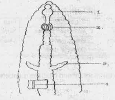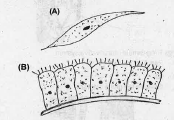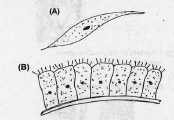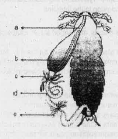Complete Solutions to EXERCISE of chapter Structural Organisation in Animals of Class 11 book with complete answers and questions
| Class 11 | BIOLOGY |
| Chapter | Structural Organisation in Animals |
| MAXIMUM PUBLICATION | EXERCISE |
| Number Of Questions | 100 |
| Academic Year | 2023-24 |
Which one of the following types of cell is involved in making of the inner walls of large blood vessels?
View SolutionTo which one of the following categories does adipose tissue belong?
View SolutionWhich one of the following is not a connective tissue?
View SolutionWhich one of the following statements, is true for cockroach?
View SolutionMatch the following with reference to Cockroch and choose the correct option

View SolutionComplete the following sentences: The most common species of frog found in India is ………………..
View SolutionComplete the following sentences: Blood Vascular system of cockroach is…………………….
View SolutionName the respiratory organs of insects.
View SolutionNote the relationship between the first two words and suggests a suitable word. Dendrons : Dendrites , Axon : ………………
View SolutionNote the relationship between the first two words and suggests a suitable word. Mast cells : Histamine , Fibroblast : ………………
View SolutionWhich among the following is the bone cell ………………. (Leukocyte, Chondrocyte, Osteocyte, Thrombocyte).
View SolutionEarthworm, segments 14-16 are covered by a prominent dark band of glandular tissue called ………………. (Setae, Clitellum, Typlosole, None of these)
View SolutionNeuroglia make up more than one half the volume of neural tissue in our body'. Write the function of neuroglial cells
View SolutionEarthworm, segments 14-16 are covered by a prominent dark band of glandular tissue called ………………. (Setae, Clitellum, Typlosole, None of these)
View Solution………………. make up more than one half the volume of neural tissue in our body.
View SolutionWhich epithelial tissue is present in the tubular parts of nephrons in kidneys?
View SolutionHeart is made of
View SolutionWrite the cellular components of blood.
View SolutionIn earthworm, setae are absent in the segments.
View SolutionIntestine of earthworm contain a special organ which help in absorption. Identify the organ.
View SolutionName the structures which help in locomotion in Earthworm.
View SolutionIn cockroach the fertilized eggs are encased in capsule called …………
View SolutionRegarding the blood vascular system of frog, some statements are given below.Check whether these are True or False and make corrections if necessary. a) Open type. b) Sinus venosus join the right atrium. c) RBC is non-nucleated. d) Circulation is achieved by the pumping action of the heart.
View SolutionYou are given two cockroaches and the teacher asked to display the mouth parts of male cockroach. How will you identify the male cockroach?
View SolutionYou are given two cockroaches and the teacher asked to display the mouth parts of male cockroach. Name the mouth parts of cockroach.
View SolutionGive one word for the following. Tissue attach one bone to another.
View SolutionGive one word for the following. The structures protect and support neurons in neural system.
View SolutionMatch the following.

View SolutionCopy the diagram and label the numbered parts.

View SolutionObserve the diagram. Name the above connective tissue. Where they found in our body ?

View SolutionObserve the diagram. Name any two principle cell found in it.

View SolutionObserve the pool of connective tissues carefully. Classify them under three headings.

View SolutionAnatomical structures of 3 animals are given below. Identify the 3 animals and arrange the structures Into 3 separate groups. (Typhlosole, Malpighian tubules, Blood glands, Cloaca, Phallic gland, Kidney, Collateral Gland).
View SolutionCopy the diagram and label the numbered parts.

View SolutionMatch the following.

View SolutionName the labeled parts a, b in the diagram given below :

View SolutionCirculating fluid of cockroach is colourless. Name the circulating fluid.
View SolutionCirculating fluid of cockroach is colourless. Name the cell concerned in it.
View SolutionGive one word for the following. Tissue specialised to store fats.
View SolutionGive one word for the following. Tissue contains fibroblasts, macrophages and mast cells
View SolutionGive one word for the following. Tissue attach skeletal muscles to bones.
View SolutionYou are glven permanent slides of a bone and cartilage. How will you identify them using a microscope.
View SolutionFrogs maintain ecological balance. As a biological student do you agree with this statement. Why?
View SolutionObserve the diagram given below and label the parts A, B, C, D.

View SolutionWhile viewing the fallopian tube through CT scan we can find large number of cilia. Mention the function of cilia.
View SolutionWhile viewing the fallopian tube through CT scan we can find large number of cilia. Mention the function of cilia.
View SolutionAn earth worm respires through skin and excretes through nephridia' Rewrite the above sentence beginning with 'A cockroach...... making appropriate changes
View SolutionMatch the following.

View SolutionIdentify the diagram and label the part marked A.

View SolutionObserve the given diagram. Identify X and Y.

View SolutionObserve the given diagram. Write any two characters of X and Y.

View SolutionThere are some physiological similarities between typhlosole and villi. Substantiate your answer.
View SolutionObserve the given diagrams. Identify A and B

View SolutionObserve the given diagrams. Write any one function of each.

View SolutionWrite the significance of : Blood
View SolutionNeuroglia make up more than one half the volume of neural tissue in our body'. Write the function of neuroglial cells
View SolutionClassify the given terms into three columns and give appropriate headings. Striated, heart muscle, intercalated disc, biceps, visceral organs, no striation.
View SolutionWhere do you find the following structure in human body : Chondrocytes
View SolutionWhere do you find the following structure in human body : Axon
View SolutionWhere do you find the following structure in human body : Osteocytes
View SolutionWhere do you find the following structure in human body : Plasma
View SolutionWrite the suitable world for the 4th place. Muscle to bone-Tendon, Bone to Bone - …………….
View SolutionWrite the suitable world for the 4th place. Bone - osteocytes , Cartilage - ……………
View SolutionWrite the suitable world for the 4th place. Cardiac Muscle - Involuntary, Striated Muscle - …………..
View SolutionWrite the suitable world for the 4th place. Contractile cell - Muscle, Excitable cell -…………..
View SolutionGive an account on Nephridia of earthworm
View SolutionYou are given an earthworm for dissection, how will you identify its anterior, posterior, dorsal and ventral sides
View SolutionBlood cell of earthworm lack haemoglobin. But blood of earthworm is red in colour. How do you account for it?
View SolutionMatch the related items from B and C with Column A.

View SolutionCopy and complete the animals on the table and the excretory organs

View SolutionIdentify the animals from the hints given below. Invertebrate, Burrowing in moist soil, Nephridia, Genital pore.
View SolutionIdentify the animals from the hints given below. Chordata, Amphibian, Kidney, Cloaca
View SolutionIdentify the animals from the hints given below. Invertebrate, Insecta, Malpighian tubules, gonapophysis,
View SolutionIdentify the statements as True or False: First segment of earthworm is Prostomium.
View SolutionIdentify the statements as True or False: Peristomium contain mouth.
View SolutionIdentify the statements as True or False: Clitellum is on segments 14-16.
View SolutionIdentify the statements as True or False: Earthworm has only a single female genital aperture
View SolutionEarthworm feeds on humus, which contain large amount of humic acid. How does the earthworm neutralises the humic acid?
View SolutionEarthworm feeds on humus, which contain large amount of humic acid. How does the earthworm neutralises the humic acid?
View SolutionThere are some physiological similarities between typhlosole and villi. Substantiate your answer.
View SolutionMention the function of the following :
a) Blood glands of 'Pheretima'
b) Hepatic caeca of 'Periplaneta americana'.
View SolutionEarthworm is a hermaphrodite animal. Where are its sex organs situated?
View SolutionEarthworms are known as 'Friends of farmers'. Give reason.
View SolutionWrite the missing word in 4th place : Dorsally - Tergites, Ventrally - ……………
View SolutionFind the relationship between given words and suggest the suitable word for the fourth place.
a) Annelida : Nephridia : :
Arthropoda : ….....
b) Osteichthyes : Cycloid scales : :
Chondrichthyes : …......
View SolutionYou are given two cockroaches and the teacher asked to display the mouth parts of male cockroach. How will you identify the male cockroach?
View SolutionWhile dissecting a cockroach to display its digestive system, a student observed certain thick white tubules. Teacher explained it as part of respiratory system . Name the tubules.
View SolutionWhile dissecting a cockroach to display its digestive system, a student observed certain thick white tubules. Teacher explained it as part of respiratory system . Name the tubules.
View SolutionIdentify the diagram given below. Identify parts from a to e.

View SolutionIdentify the diagram given below. Identify parts from a to e.

View SolutionCirculating fluid of cockroach is colourless. Name the circulating fluid.
View SolutionCockroach is uricotelic animal. Give reason.
View SolutionName the four structure helps in excretion in cockroaches.
View SolutionIf the head of cockroach is cut off, it will still alive for as long as one week. Give reason
View SolutionName the sensory organs of cockroaches
View SolutionCompound eyes are more effective than vertebrate eye. Give reason
View SolutionFrog show sexual dimorphism. Write the morphological difference present only in male frog
View SolutionPrepare a flow chart showing the flow of food in the alimentary canal of frog. Compare it with alimentary canal of cockroach.
View SolutionCloaca is a common opening of 3 tubes or tracts. Name the tracts which opens to cloaca.
View SolutionCloaca is a common opening of 3 tubes or tracts. Name the tracts which opens to cloaca.
View Solution
EXERCISE questions and complete solutions for chapter Structural Organisation in Animals of MAXIMUM PUBLICATION of Class 11